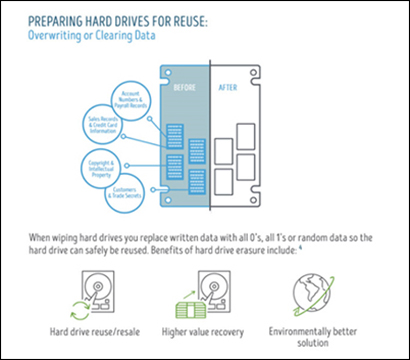Click here to view Part 2.
to view Part 2.
Varying specifications of hard drives can be the first step in assessing whether the device can be reused or should be processed for end-of-life recycling. When preparing a hard drive for reuse you can wipe the hard drive to protect your company and ensure data removal. Data wiping consists of replacing written data with all zeros, all ones or random data. This enables the hard drive to be safely and securely reused or resold, extending the life of the device.
You can choose to have a hard drive wiped just once, or multiple times. If a hard drive was manufactured after 2007, a single-pass wipe will suffice. Otherwise, drives manufactured before 2007 need to be wiped multiple times but often the value of the drive doesn’t justify this so end-of-life recycling tends to be the most reasonable choice.
There are several benefits that result from secure data wiping. As long as a hard drive is wiped for example, you can maximize the value of that device by reusing or reselling the equipment. You will have a higher return on a working piece of equipment rather than a scrap device. This is also the most environmentally-friendly solution because you are helping extend the life of working resources.
Click here for “Part 4” of our five-part hard drive data destruction series.
For more information on hard drive data security, download our complimentary whitepaper on “5 Things You Can Do to Avoid a Data Breach During IT Asset Disposition”.